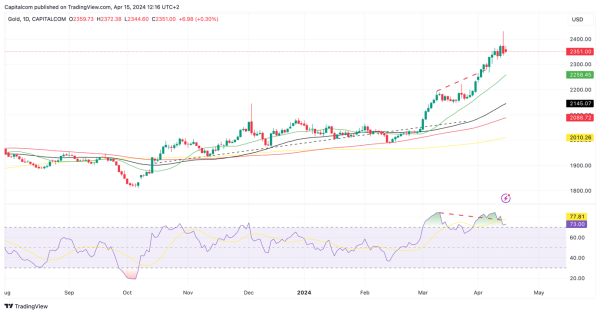Gold price in 2024: geopolitical tensions and rate-cut expectations keep XAU/USD supported
The price information and economic data in this article are sourced from Investing.com, and Reuters.
Investors are keeping a close eye on gold as the conflict in the Middle East escalates with a possibility of a full-scale regional war in the area. Iran’s missile attack on Israel – a response to a suspected Israeli strike on the Iranian consulate in Damascus, Syria, earlier this month – was the first time it had engaged directly rather than through surrogates. The attacks were thwarted by Israel’s defence forces, but even so, they do not seem to have been aimed at big civilian centres. Iran has said the attack has concluded, but many fear Israel will retaliate, even if its international allies are calling for it to declare the issue closed.
This has caused a fresh wave of risk-off sentiment across markets, weighing on equities and pausing the strong bullish momentum which has dominated in recent months. Meanwhile, gold and silver have been attracting safe-haven flows, as investors look to safeguard some of their capital. Gold has risen almost 20% in the past six weeks, whilst silver has outshined this by appreciating over 30%.
The fact that the UK, France and Egypt condemned Iran's action while Saudi Arabia has called for restraint has calmed some of the concern in markets, leading to a corrective pullback in both gold and silver. This doesn’t mean that the bias has turned bearish, as this is mostly a technical pullback. If anything, it could allow new buyers to come in.
XAU/USD (Gold) daily chart

(Past performance is not a reliable indicator of future results)
If we focus more on the longer term, the bias for gold remains higher. Most of the current variables support this view. Firstly, geopolitical tensions are expected to remain. Secondly, the precious metal has remained remarkably strong despite continued stronger data from the US, highlighting the fact that the current bull market is not being driven by the usual macroeconomic drivers. Thirdly, the Federal Reserve is expected to cut rates this year – even if it is by much less than originally expected – which is positive for gold prices. And lastly, there are still concerns about economic downturn and recession, even if the US is holding up remarkably well, the same cannot be said for Europe and parts of Asia. It is also important to note that many central banks have increased their purchases of gold, which has also pushed prices higher.
Adding all this up, we can conclude that if gold managed to be so resilient throughout the past year – with rates at unusually high levels in most developed countries and an extremely buoyant stock market – one can expect the bullish bias to improve with expectations of widespread rate cuts alongside geopolitical and economic concerns.
Evidence of this is the fact that many institutional investors have had to revise their gold price forecasts higher. Goldman Sachs expects the outlook for gold to remain bright, revising the forecast to $2,700 from $2,300 earlier this year.
The price information and economic data in this article are sourced from Investing.com, and Reuters.